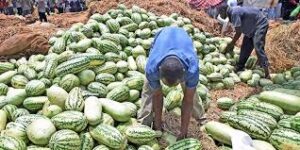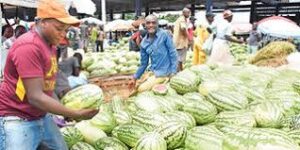

Watermelons are a member of the Cucurbitacceae family which includes squash, pumpkins, cucumbers, muskmelons, and gourds. Individual plants produce both male and female flowers and fruit sizes varies from 2 to 14kg, depending on variety. However, seedless varieties will require pollinators. Watermelon leaves are dark green, with prominent veins. They have three large lobes, each further divided into small lobes. Watermelon leaves are heart shaped with three to seven lobes per leaf and are produced on trailing vines.
Cultivars
Selecting the best watermelon variety is the most important decision made by any producer. Planting a variety watermelons that is not suited for the available market and the particular production situation leads to lower profits or possibly crop failure. In addition to market acceptability, a variety must have an acceptable yield, be adapted to the production area and have the highest level of needed pest resistance available.
The major watermelon varieties and types produced are Charleston, Gray Strains, Crimson Sweet, Jubilee, All sweet, Royal Sweet, Sangria, Triploid Seedless, and Black Diamond types.
Temperatures
Watermelons are sensitive to cold temperatures and even a mild frost can severely damage the crop. The best average temperature range for watermelon production during the growing season is between 18°C and 35°C. Temperatures above 35°C or below 10°C will slow the growth and maturation of the crop.
Soil Requirements
Watermelons row best on non-saline sandy loam or silt loam soils. Light – textured fields warm up faster in the spring and are therefore favored for early production. Very sandy soils have limited water – holding capacities and must be carefully irrigated and fertilized to allow for high yield potential. The soil should have a pH of ,8 to 6,6.
Planting
In the winter rainfall area watermelons are planted in September and October, in the Limpopo and Mpumalanga Lowveld from June to August, and in the rest of the country from August to October. The crop matures 3 months after planting, and the yield varies from five to 72 t/h.a.
NEED TO KNOW MORE OR HELP WITH A PROFESSIONAL FARMING BUSINESS PLAN CONTACT US NOW: (27) 084 583 3143 OR EMAIL: money@global.co.za

